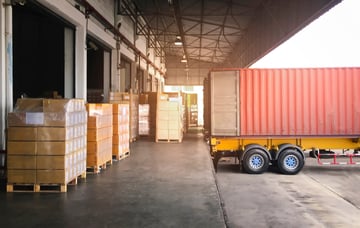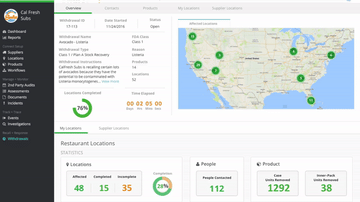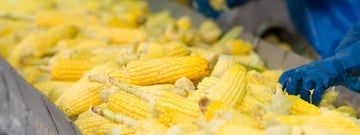You’ve seen the headlines: “Unknown Source Causes Multistate Foodborne Illness Outbreak.” The troubling part from a food safety perspective is the word unknown. The E. coli outbreak linked to romaine lettuce was first announced by the Center for Disease Control in March. Two months later we have yet to determine the source of the contaminated food. This exemplifies the complexity of the food supply chain. Navigating suppliers, COAs, and emails during a food safety scare impacts the QA team’s ability to respond quickly. Response time is key when it comes to mitigating risks along the supply chain.
Once the food source is identified, a complex system emerges. The FDA article Guide to Minimize Microbial Food Safety Hazards of Leafy Greens provides a simplified overview of the supply chain and the journey a simple ingredient such as lettuce undergoes when traveling from field to fork. When you have a product that has five or more ingredients, the supply chain expands. For instance, a salad kit will have lettuce, carrots, cabbage and a dressing packet. The dressing packet may have oil, salt, vinegar, sugar, and natural flavors. When an issue is identified by the end use consumer, the unknown food source must be quickly narrowed down in order to trace back to the lot number. Each step from field production to retail involves thousands of people and the potential introduction of a safety risk.
You need food supply chain transparency and a fast, accurate food recall solution to ensure the most rapid response possible.
Pathogens such as Listeria might make the headlines when it comes to recalls, but they are not the major cause for most companies. According to Food Safety Magazine’s annual review of recalls, undeclared allergens are still the leading cause of food industry recalls.
The top reasons for a food recall are:
- Undeclared allergens: Allergens continue to be the major cause for pulling products from store shelves; in fact, in 2017, there were 218 products affected. The top allergens that find their way into processed foods are milk, egg, and soy. Cross contamination should be addressed with employee training programs and hazard control checkpoints during manufacturing.
- Microbiological contamination: This kind of contamination accounted for 146 recalls in 2017. Listeria was found in cheese, Salmonella was found in many product categories from chips to candy, and E. coli was found in beef.
- Foreign material contamination: In 2017, there were 42 recalls caused by foreign material contamination. The recalls included metal, hard plastic, and more recently, glass.
You’ve built trust with your consumers as a company that values safety, quality, and transparency, and they expect safe food. In a digital world, information about food recalls or withdrawals is easily obtainable and spreads quickly when known food safety issues go untreated. For example, Food Safety Magazine’s report goes on to mention a case of Listeria contamination that was detected by FDA testing in artisanal cheeses. The product was distributed nationwide, and a recall was issued in 2017. According to the report, the company had positive swab tests between 2014 and 2017 that showed Listeria was present throughout the entire facility.
Championing food sustainability with a farm-to-fork brand story doesn’t matter if you don’t include food safety. A recall can cause financial loss and severe damage to your brand messaging and identity. How quickly you identify the risk, gather lot/batch numbers, and confirm where the contaminated product was sold will be crucial. A swift resolution requires an extremely agile approach when accessing data along the food supply chain.
Under new FSMA regulations, food companies must have a food safety plan in place. Part of this plan must include a supplier verification and approval process as a preventive control. A partnership with approved suppliers also allows for product traceability to the lot level. That in-depth traceability provides visibility of the entire food supply chain for your brand. Rather than sifting through stacks of COAs and supplier documents, FoodLogiQ Connect offers supplier information with the click of a button from your dashboard. You can track down lot numbers and trace the material throughout the supply chain. Ease of access gives you the ability to respond quickly and accurately, keeping your brand out of the food recall headlines.
Incorporating a food recall solution such as FoodLogiQ’s Recall + Response will allow you to standardize communications across your supply chain and respond to food recalls with speed and accuracy. This enables fast response time and ensures your consumers’ safety. Using technology to connect each step from farm to fork allows you to be proactive and assure quality.
For more information on FoodLogiQ's Recall + Response solution, Request a demo.
Other posts you might be interested in
View All Posts
Food Industry
6 min read
| April 11, 2023
Why Your Business Should Build Agile Supply Chains and Where to Start
Read More
Food Industry
6 min read
| May 18, 2017
FoodLogiQ Disrupts the Food Industry with Market’s First Real-Time Recall Management Solution
Read More
Food Industry
7 min read
| June 29, 2022

